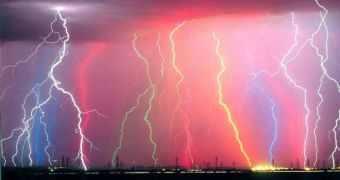Air friction would be something to begin with; on the other hand, multiple studies conducted over decades have shown that the electrical fields generated through this process are not able to create even a spark, not to talk about an electric disruptive discharge several hundred meters long. Even if we take into consideration the energy generated during precipitation, the electric field is not powerful enough. Nonetheless, millions of lightning bolts stream through the atmosphere every day, thus there must exist an alternative explanation.
One physicist proposes a radical new solution. Cosmic rays. Russian Alex Gurevich from the Lebedev Physical Institute suggests that energetic particles emitted from the Sun and supernova explosions all over the Milky Way may contribute to lightning by forming a conductive path through the atmosphere, to initiate the electric discharge.
The Earth's atmosphere is an excellent electrical insulator with relatively high breakdown voltages, so it is not very hard to believe that electric fields generated by air movements cannot easily spark lightning bolts through it. Furthermore, particles that initiate the energy discharge have been proven to exist. Spark chambers, for example, using very low voltages can be triggered to spark with relative ease as long as there are enough free electrons inside it.
The process is commonly known as ionization, and while a particle passes through the gap between the spark electrons, it leaves a trail behind, which can be followed by other particles. Nevertheless, there is a big difference between the atmosphere and a spark chamber, and a handful of particles are just not enough to trigger a lightning.
Although there are massive amounts of cosmic rays raining down on Earth, the truth it that very little can penetrate through the whole atmosphere. Gurevich proposes an exotic mechanism. Because of the very low number of particles streaming down through the atmosphere, he suggests that the electric fields generated during a thunderstorm would multiply them through a process called 'runaway breakdown'.
Runaway breakdown basically implies that, as cosmic ray electrons travel through relatively powerful electric fields, they gain energy and then collide with atoms inside the atmosphere to generate a second electron, plus a fair amount of energy in the form of x-ray and gamma ray radiation, that would also contribute to the runaway effect.
Now be ready for the weird part. Scientists have previously been able to detect runaway effects in low energy electric fields, not to mention the x-ray and gamma ray emissions, however it is still uncertain if the runaway effect can be held responsible for triggering lightnings. But why? Lets put it this way: scientists have a hard time understanding how a shower of particles moving randomly through the atmosphere can generate electrical flows in the form of a hot conductive channel of electrons only a few centimeters in diameter, thus the faith of lightning initiation remains uncertain for now.

 14 DAY TRIAL //
14 DAY TRIAL //